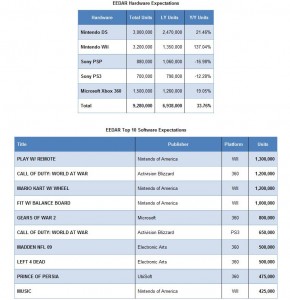EEDAR – How Nintendo saved Christmas

Software Sales
We expect software sales for December, 2008 to come in at $2.7 billion, a 14% increase over last year. This was primarily driven by the next-generation home and portable software titles. Unit sales are likely to increase by 12% over last year with a modest 2% increase in the average selling price (ASP). The 2% increase in ASP differs from current trends as the growth in ASPs over the years has played a tremendous role in driving sales. We believe that heavy retail discounting, an increased competitive environment, and a greater than expected surge in DS and Wii game sales all played a significant role in driving down the yearly ASP growth.
How Nintendo Saved Christmas
Every next-generation system—except for the PSP—is expected to post year-over-year software unit sales increases in the double digits. In terms of pure dollar and unit growth, the Nintendo’s systems are expected to lead the way by an unprecedented amount. In fact, Nintendo Wii and DS software unit and dollar sales will account for over 50% of all games sold in December. Without these sales, the industry would have likely felt the full wrath of the recession—much like other industries closely linked to gaming. We believe their simple to use design, cheaper and wider variety of software titles, and the already “hot effect” in place on both systems, all played a role in driving both the Wii and the DS to the top of their segments. Simply put, Nintendo saved Christmas.
Key Take-Aways
· 145 titles are likely to exceed 100,000 units; the highest on record for a single month.
· Nintendo Wii is expected to sell 3.2M units in the United States in one month; the highest on record for any single console platform.
· Four third-party titles will likely place in the top ten for unit sales on the Nintendo WIi; four on the Nintendo DS; eight on the Playstation 3; nine on the Xbox 360.
· Nintendo is expected to have the most titles in the top 30 at 11. Second will be EA at 6, followed by Activision at 4. (Note: Each Guitar Hero SKU is countered separately at 3 per platform, which is why only 2 made it into the top 30.)
Where Have All the Hardcore Gamers Gone?
We expect only 8 out of the top 30 SKUs in December to hold a Teen or Mature ESRB Rating. This has led many to ask, where have all the hardcore gamers gone? Of course, this is not to suggest that Teen or Mature rated games are “hardcore” or “core” targeted titles, but there is obviously a strong correlation. First, we must understand that while our industry has shown impressive growth over the last 2 years, the core gaming base has only sustained a much smaller growth rate. Teen and Mature rated titles have seen a 15% increase in releases over 2007, however, we estimate that the core gaming consumer base has not been able to match equal or greater growth over the same period. In other words, the average per unit sales of a game targeting the core audience has decreased since 2007. Furthermore, the December month is primarily driven by gift givers, which target a broader casual and mainstream audience.
Looking Ahead Into 2009
With 2007 and 2008 posting some of the industry’s largest comps for a two year span, we do not expect 2009 to post similar results. Currently, EEDAR expects high single digit increases for software sales in 2009. We believe that there exists a significant amount of upside to these figures but that will vary widely depending on hardware pricing and the Nintendo Wii’s momentum.
Hardware Sales
EEDAR does not expect any surprises in December. The Nintendo Wii and the DS will, again, lead the pack by an immense margin, with the Xbox 360 in a distant third, followed by the two Sony systems, the PS3 and the PSP. The Wii’s tremendous success was backed by an enormous amount of supply shipped into the channel. Data from the used market supports this assumption. Last December, the Nintendo Wii’s average selling price in these gray markets was $470; this was reduced to $350 in December 2008. We believe the decline in the gray market price is a strong reflection of the increased supply in the channel and not a reflection of a decrease in demand. For December 2008, we project that the Wii would have likely sold north of 4 million units had supply and demand been in equilibrium.

